Roman Society Day Excursion
There is nothing more exciting than discovering an object whilst digging on an archaeological excavation. That precise moment when you see something unusual poking out of the ground and the anticipation as you remove the dirt to reveal for the first time something that has been left undisturbed for hundreds of years. In February 2015 an incredibly rare Romano-British tombstone was unearthed during excavations by Cotswold Archaeology at the former Bridges Garage site, Tetbury Road, Cirencester. The tombstone of Bodicacia is one of many finds that are displayed at the Corinium Museum in Cirencester, however there are many steps in the process from the initial discovery of an object, to its final display in a museum.
On Saturday 21st July a special event organised by the Corinium Museum and Cotswold Archaeology, and funded by the Roman Society, invited Museum and Roman Society Members to board a bus and go on a journey to learn about the process of archaeological discovery to display.

The journey began at the Beeches Road Car Park where the famous Hare Mosaic was revealed during excavation in 1971. It was lifted in sections and is now on display in the Corinium Museum.
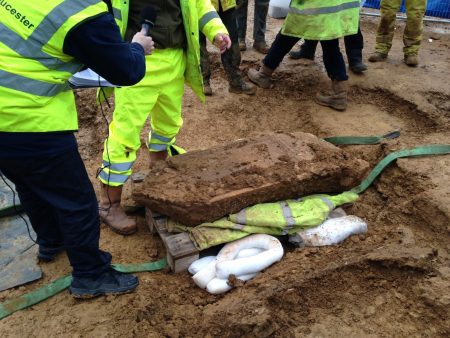
The bus departed Cirencester and passed the offices of St James’ Place where the Bodicacia tombstone and bronze cockerel were found during excavations in 2015 and 2011.
It then arrived at Cotswold Archaeology’s Cirencester Office based at Kemble. Cotswold Archaeology was established in 1989 as a commercial unit that offers a range of heritage services, including excavation and post-excavation analysis. The group was welcomed by Chief Executive, Neil Holbrook and Martin Watts, Head of the Cirencester Office. Martin talked the group through what happens when the archaeologists return from site laden with their equipment and material, including finds, from the day’s excavation and took the group on a behind the scenes tour of the unit.
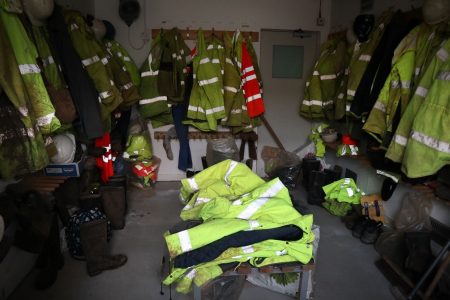
Entering through the back doors we passed the “cloakroom” where all the archaeologists’ gear is stored.
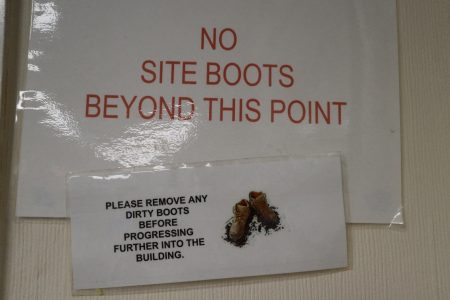
A sign strategically located halfway down the corridor reminds forgetful archaeologists not to proceed any further in their boots!

We were taken into the laboratories where the archaeological finds are processed. The large room contains several sinks for washing the material clean of dirt. Pull-out trays stacked high with their site references written on them contain the washed excavation material. A connecting room is fitted out with microscopes for on-site specialists to conduct analysis of the material. Where required material will undergo conservation work to stabilize it before it is deposited with a museum.

Once the material has been processed it is then packaged according to the receiving museum’s archaeological archive deposition guidelines. This includes packing it in a plastic or cardboard box with conservation grade packaging, which may or may not include silica gel, depending on the object. The size of the box will vary depending on each museum’s specification, therefore, Cotswold Archaeology keep a supply of varying sizes. The boxes are all numbered up with the site code, context number and box number ready to be deposited with the museum. These are kept in store until they are ready to depart the unit in one of the specialist vans.
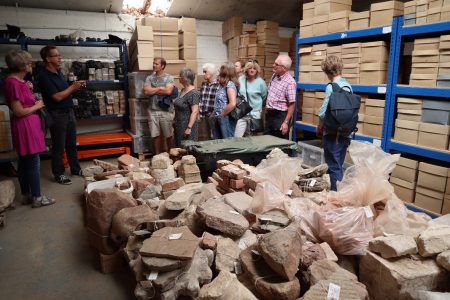
Following the tour, we were encouraged to step into an archaeologist’s boots by making our own cup of tea! We heard from Martin about one of the most significant excavations to happen in Cirencester for over 50 years, the St James’ Place excavations, which led to the discovery of the bronze cockerel and Bodicacia tombstone. He told us about the difficult circumstances in which the excavation team had to dig. The site had been a petrol garage previously, where fuel had leaked into the surrounding ground, meaning that large areas were too contaminated to excavate. It required the archaeologists to where specialist protective clothing and the ground conditions were carefully monitored. He also told us how the cockerel was discovered, who found it and how it was lifted out of the ground; and about the details leading up to the revealing of the Bodicacia tombstone on live radio.
After a most enjoyable and insightful morning, the group then boarded the bus and set off for the Corinium Museum’s storage facility located in Northleach.
The Museum’s collections store received substantial funding during the Corinium Project (2002 – 2004), a Heritage Lottery funded project, to install a mezzanine level, dedicated stone store, roller-racking and air-handling plant for environmental control. The group were welcomed by Dr Alison Brookes, the Collections Development Officer at the Corinium Museum. Alison talked the group through the process for archaeological archive deposition, from when the boxes arrive at the stores, to formally making the contents part of the Museum’s collections. She explained the Museum’s documentation procedures: entry forms, cataloguing and accessioning objects using the Museum’s numbering system. She then led the group through the different areas explaining what was stored where and what specific conservation requirements had to be met.
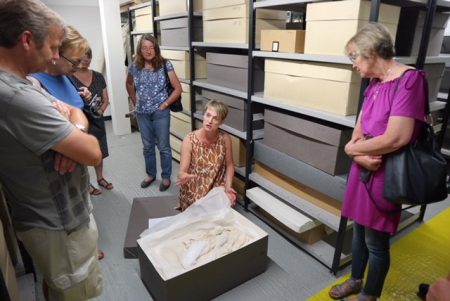
Alison in the Costume Store describing the Museum’s pest management controls that the Collections Team follow to prevent any damage to objects.
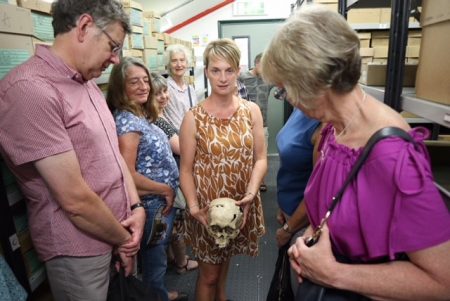
Alison discussed the importance of the human remains collections for on-going scientific research. She is holding a Romano-British adult male skull with a puncture wound to the top of the skull showing evidence that the bone had started to heal. This is a very rare example of a person having survived trepanation.
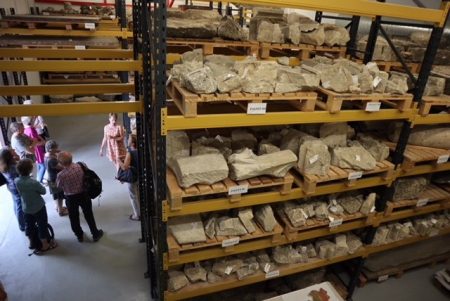
The final stop was the Museum’s stone store containing the St Mary’s Abbey excavation archive and Romano-British architectural and religious sculpture.
The last visit of the day was a trip to the Corinium Museum, where Director Amanda Hart began with a talk about the museological considerations of display. This included historical approaches to display and how that has changed over time; interpretation and the narrative framework of museum collections. She also discussed the practicalities of display from conservation to mounting objects, emphasizing two recent examples of display using the bronze cockerel and Bodicacia tombstone to complete the story of Discovery to Display.

The lifting of the Hunting Dogs mosaic from Dyer Street, one of two mosaics that led to the building of the first Corinium Museum in 1849, illustrating the complexities of moving objects.
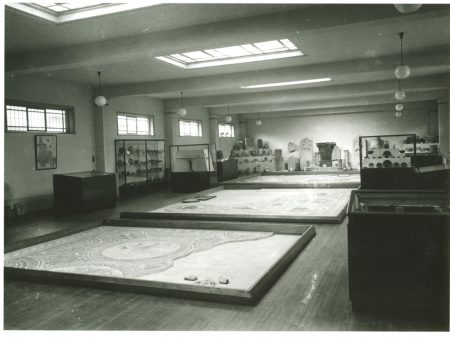
The displays in the newly opened Corinium Museum in Park Street, Cirencester, 1938, showing limited interpretation.
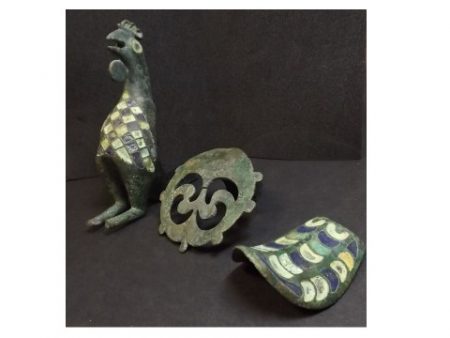
The bronze cockerel from the St James’ Place excavations in three pieces prior to display. The conservator used velcro to adhere the tail and back to the main body of the cockerel. The mounter created a special acrylic seat for it to sit on to hold all three parts together. This was used as a recent case study to highlight the complexities of mounting an object.

The tombstone was found face down on top of a 4th century Romano-British grave and had been used as a grave marker. Amanda talked about the significance of the Bodicacia tombstone and the deliberate chiseling of Oceanus’ face indicating an early example of iconoclasm.
Amanda ended the day talking about the Museum’s current development project “Stone Age to Corinium” funded by the Heritage Lottery Fund. She gave an overview of developing new exhibitions and the process of writing an interpretative framework, selecting the objects and designing the displays, conservation work, and reconstructing archaeology. For more information about the project visit https://coriniummuseum.org/support-us/stone-age-to-corinium/
A fun and informative day was had by all. People enjoyed finding out about “the details of what goes on behind the scenes between discovery and display of items” and “following the whole process through from start to finish”.
“Thanks for organising a really interesting day on Saturday. It certainly showed the amount of work, dedication and patience needed to create each display in the museum.” Denise.











Comments
It’s hard to come by experienced people in this particular topic, however, you seem like you know what you’re talking about!
Thanks